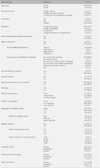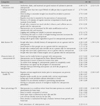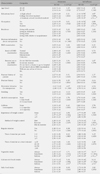Abstract
Purpose
This study was done to determine the level of awareness and self-efficacy and their relationships to osteoporosis among young women.
Methods
The participants were 309 young women living in Seoul. The data were collected using questionnaires from July to September 2009. The Osteoporosis Awareness Scale consists of five areas with a total of 31 questions and the Self-efficacy Scale consists of 18 questions. Data were analyzed using descriptive analysis, t-test, ANOVA, Scheffé test and Pearson's correlation coefficients.
Results
The average level for osteoporosis awareness was 2.22, of a possible 4.00 and significant difference were related to participants' previous encounter with any information about osteoporosis, behavior to prevent osteoporosis, experience of weight control, and frequency of vegetable and calcium-rich foods intake. The average level of self-efficacy for osteoporosis was 2.81, of a possible 4.00 and significant difference related to participants' educational level, occupation, behavior to prevent osteoporosis, smoking, method of weight control, regular exercise, and frequency of vegetable and calcium-rich foods intake. There were significant positive correlations among awareness and self-efficacy about osteoporosis
Figures and Tables
References
1. Ailinger R.L., Braun M.A., Lasus H., Whitt K. Factors influencing osteoporosis knowledge: A community study. Journal of Community Health Nursing. 2005. 22(3):135–142.
2. Bandura A. Social foundations of thought and action: A social cognitive theory. 1985. Englewood Cliffs: Prentice-Hall.
3. Chang Y.K., Seo H.J., Jin Y.W., Joeng M.S., Sung S.H., Park D.Y, et al. The prevalence and risk factor of osteopenia and osteoporosis in 40-59 year-old male workers. Korean Journal of Occupational and Environmental Medicine. 2006. 18(2):130–137.
4. Choi E.S., Kim J.H., Chung M.Y., Hwang K.H. Development of an osteoporosis awareness scale for women. Journal of Korean Academy of Nursing. 2008. 38(6):813–821.
5. Choi H.J. Risk factors and assessment of low bone mass in the young adult female. Korean Journal of Family Medicine. 2009. 30(12):924–933.
6. Chung M.Y., Hwang K.H., Choi E.S. Study of the level of osteoporosis awareness among women dwelling in urban area. Korean Journal of Women Health Nursing. 2009. 15(4):362–371.
7. Cohen J. Statistical power analysis for the behavioral sciences. 1988. 2nd ed. Hillsdale, NJ: Routledge Academic.
8. Gemalmaz A., Oge A. Knowledge and awareness about osteoporosis and its related factors among rural Turkish women. Clinical Rheumatology. 2008. 27(6):723–728.
9. Kang H.Y. Relationship among life style, body composition, and bone mineral density (BMD) in female college students. Journal of Korean Academy of Fundamentals Nursing. 2009. 16(3):325–332.
10. Kasper M.J., Garber M., Walsdorf K. Young women's knowledge and beliefs about osteoporosis: Results from a cross-sectional survey of college females. American Journal of Health Education. 2007. 38(4):186–193.
11. Kim M.H., Kim M.S. A study on the relationships between knowledge about osteoporosis and cognitive factors in middle-aged women. Korean Journal of Women Health Nursing. 2005. 11(1):52–57.
12. Kjaerbye-Thygesen A., Munk C., Ottesen B., Kjaer S.K. Why do slim women consider themselves too heavy? A characterization of adult women considering their body weight as too heavy. The International Journal of Eating Disorders. 2004. 35(3):275–285.
13. Krall E.A., Dawson-Hughes B. Smoking and bone loss among postmenopausal women. Journal of Bone and Mineral Research. 1991. 6(4):331–338.
14. Lee S.H. Prediction model on osteoporosis prevention behavior in middle aged women. 2006. Seoul: Korea University;Unpublished doctorial dissertation.
15. Lynn M.R. Determination and quantification of content validity. Nursing Research. 1986. 35(6):382–385.
16. Mezuk B., Eaton W.W., Golden S.H. Depression and osteoporosis: Epidemiology and potential mediating pathways. Osteoporosis International. 2008. 19(1):1–12.
17. Ministry for Health Welfare and Family Affairs. Study of an osteoporosis management program in Korea. 2007. Seoul: Author.
18. Ministry for Health Welfare and Family Affairs & Korea Center for Disease Control and Prevention. 2007 Korea national health & nutrition examination survey. 2008. Seoul: Author.
19. Fast facts on osteoporosis. National Osteoporosis Foundation data. 2009. Retrieved May 30, 2009. from http://www.nof.org/osteoporosis/diseasefacts.htm.
20. NIH Consensus Development Panel on Osteoporosis Prevention, Diagnosis, and Therapy. Osteoporosis prevention, diagnosis, and therapy. JAMA: Journal of the American Medical Association. 2001. 285(6):785–795.
21. Piaseu N., Schepp K., Belza B. Causal analysis of exercise and calcium intake behaviors for osteoporosis prevention among young women in Thailand. Health Care for Women International. 2002. 23(4):364–376.
22. Sharkey N.A., Williams N.I., Guerin J.B. The role of exercise in the prevention and treatment of osteoporosis and osteoarthritis. The Nursing clinics of North America. 2000. 35(1):209–221.
23. Shin K.R., Kang Y.M. A study on the relaitonships between osteoporosis knowledge, self-efficacy and health belief of women in an Island. Journal of Korean Academy of Nursing. 2002. 32(1):89–99.
24. Shin S.J., Shin K.R., Yi H.R., Ju S.K. Knowledge, health belief, and self-efficacy related to osteoporosis. Journal of Korean Academy of Nursing. 2005. 35(5):850–857.
25. Song H.R., So H.Y. Effects of the knowledge, health belief, and self-efficacy about osteoporosis on calcium intake behavior for postmenopausal osteoporosis patients. Journal of Korean Academy of Adult Nursing. 2007. 19(5):763–774.
26. Sun K.S. The effect of web-based osteoporosis prevention program on the osteoporosis knowledge, self efficacy, health belief, stage of change in female college students. 2003. Gwangju: Chonnam National University;Unpublished doctorial dissertation.
27. Won I.S. A study on osteoporosis knowledge, self-efficacy, health promoting behaviors and BMD among adult women. 2009. Daejeon: Eulji University;Unpublished master's thesis.
28. Yang S.A. A study on the relationships between osteoporosis knowledge, self-efficacy and health belief of women in urban city. Korean Journal of Women Health Nursing. 2005. 6(2):19–44.
29. Yoo S.Y. Analysis of factors affecting bone mineral density of young females in Seoul area. 2008. Seoul: Sungshin Women's University;Unpublished master's thesis.
30. Yoon E.J. Model explaining variance in health promoting behavior and quality of life in women with osteoporosis. 2001. Seoul: Kyung Hee University;Unpublished doctorial dissertation.




 PDF
PDF ePub
ePub Citation
Citation Print
Print







 XML Download
XML Download